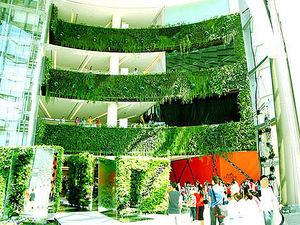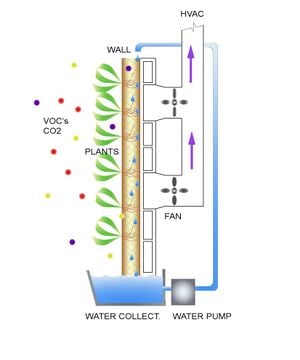
A green wall is a wall, that is partially or completely covered with vegetation and, in some cases, also with soil or an inorganic growing medium. The wall can be either free-standing or part of a building. There are two main types of green walls: green façades and living walls. Green façades are walls covered with climbing plants which are rooted in the ground. Living walls are walls covered by plants which do not root in the ground, yet root in soil or mats suspended on the wall itself. With green façades the plants are always on outside walls; with living walls the plants can be attached either on interior or exterior walls.[1]
Overview[edit | edit source]
Green façades[edit | edit source]
Green façades can be very easily made, by simply placing suitable plants next to the wall. Some popular plants (for temperate climates) include:
- Actinidia
- Akebia quinata/trifoliata
- Aristolochia
- Campsis
- Celastrus
- Clematis
- Cotoneaster
- Euonymus fortunei
- Hedera
- Heuchera
- Humulus lupulus
- Hydrangea petiolaris
- Lonicera
- Nephrolepis
- Parthenocissus tricuspidata]]/Parthenocissus quinquefolia|quinquefolia/Parthenocissus inserta|inserta
- Vitis berlandieri / riparia
- Polygonum auberti
- Pyracantha
- Selaginella
- Wisteria
Living walls[edit | edit source]
There are 2 types of living walls: without and with a substrate. The most used substrate is sphagnum.
Living walls have been used for centuries in Europe; whether this was an intentional use of living walls or a natural process of local flora overtaking an available medium probably depended on the cultural status of the occupants. Today living walls are re-entering the spotlight as an environmentally friendly way to reduce energy costs and bring nature back into the human landscape.
- Living walls are a relatively untapped art and architectural medium where living plants become a dynamic and evolving artwork that requires periodic upkeep.
- Living walls can be purely decorative, produce food or medicinal plants in small areas, provide energy savings through reduced heat absorption, and even improve the quality of indoor air.
Why Build Living Walls?[edit | edit source]
Benefits of living walls include:
- Lowering energy consumption and greenhouse gas emissions
- Reduction of Urban Heat Island Effect (UHIE)
- Increasing the thermal performance of buildings(lowering energy costs)
- Improvement of Indoor Air Quality (IAQ)
- Reduction of Noise Pollution
- Increasing urban biodiversity and urban food production
- Improvement of health and well-being.[2]
Health Benefits[edit | edit source]
According to the U.S. EPA, indoor air quality can sometimes be much worse than the outdoor air quality of the most polluted cities. Constant exposure to poor air quality can cause asthma, irritation, and a myriad of other health problems. Poor indoor air quality is often due to poor ventilation and off-gassing of Volatile Organic Compounds (VOCs) from carpets, paints, upholstery, insulation,and countless other common products. Remedies for poor air on a small scale is limited to opening windows and fans while large scale systems often use Heating, Ventilating, and Air Conditioning (HVAC) systems. Living walls can be used on any scale to improve the indoor air quality.
Living walls provide health benefits on both the physical and psychological levels. The plants use CO2 and circulate the air in the room, removing VOC's from the ambient air. This reduces negative health effects associated with VOC's and poor indoor air. Living walls therefore improve air quality through photosynthesizing; absorbing CO2 and emitting oxygen.
On a psychological level, plants can provide a calming effect as well as increase worker efficiency. Quantifying a psychological benefit from plants in a person's space is somewhat difficult. However, qualitative reports of general improvement in mood and calmness are common in measuring effects of plants on human psychology.
Energy Savings[edit | edit source]
Exterior walls Living walls reduce heat island effect. The sun's energy that used to reflect and radiate heat off of buildings is now absorbed by the growing plants.
Living walls reduce indoor cooling needs and costs. Shading from the plants on an exterior wall can decrease the temperature inside the building. Lower temperatures indoors reduce the need for air conditioning.
Noise Reduction[edit | edit source]
Living walls absorb sound waves, reducing city noise.
Reduction of Storm Water Runoff[edit | edit source]
The soil from living walls absorbs rain, reducing runoff.
Building Protection[edit | edit source]
- Living walls absorbs acid rain, keeping it off the building.
- They protect against ultraviolet rays.
- They reduce temperature change, which reduces expansion and contraction of building materials.
Creation of Habitat[edit | edit source]
Living walls create habitat for microorganisms, insects, and birds.
Application/Uses[edit | edit source]
How do Living Walls Improve Indoor Air Quality?[edit | edit source]
Air quality is improved by a biological process called biofiltration. Air can be forced past the plants and the soil medium containing microbes, which remove VOC's, dust, and dirt particles from the air. The pollutants from the air are absorbed into a liquid phase and consumed by the microbes. The microbes use the pollutants as an energy source and degrade them to carbon dioxide and water. The air is then pumped through the traditional HVAC system and is redistributed into the building. An estimated 65% to 90% of VOC's have been removed using biofiltration.

How Do Living Walls Reduce Cooling Costs?[edit | edit source]
Shading from the plants on a sunlit wall reduces the amount of direct light hitting the structure. The energy absorbed by the plants is converted into sugars through photosynthesis instead of reflecting and radiating most of the energy (heat) striking the wall.
Indoor living walls can also reduce cooling/heating costs. Traditional HVAC systems must, by code, replace a certain amount of indoor air with fresh outdoor air every hour. While this is being accomplished, the outdoor air must be heated/cooled to the desired indoor temperature. With an indoor living wall system the same air is used over and over again. The air is filtered by the living wall and maintains its temperature, eliminating the need to heat and/or cool outdoor air.
Design[edit | edit source]
How are Living Walls Made?[edit | edit source]
Any plant requires a type of growing medium. Some plants require a lot of medium in order to flourish, other plants need very little. The first element to building a living wall is the physical structure of the wall. Plants need water and moist soil, two things not commonly found anywhere near drywall. Some method of retaining the drip from plants and soil is a good first step, for example, building little cubbies at slight upward angles.
Types of Living Walls[edit | edit source]
Living walls to choose from:
- Living walls can be made using a pallet[3]
- The panel system is a pre-planted system that you can buy from a company such as panel specialists at ELT Living Wall Systems,[4] VertiGarden,....[5] Once purchased you can either install the panels yourself or have an expert install them for you onto an existing wall, indoors or outdoors, along with an irrigation system.
- In Felt Systems plants are fitted into felt pockets of growing medium and then attached to a waterproofed backing which is then connected to the building behind. An example of a felt system is Patrick Blanc's Vertical Garden and Bacsac Sac by Sac.[6] Patrick's system is composed of a metal frame, a thin PVC sheet, and a felt polyamode layer which is attached to the PVC.
- They can also be made DIY using a metal grating dressed with a jute mat and filled with potting soil, or using a EPDM plastic with felt matting, and sacs with potting soil and a irrigation system
- Finally, a container/trellis system consists of vegetation that is grown in containers which climb onto trellises. Irrigation drip lines are put in place to control the watering and feeding of the plants.[2]
What is the Scale of a Living Wall?[edit | edit source]
Living walls can be adapted to almost any size a photo gallery of living walls
Maintenance[edit | edit source]
If you consider living walls before the building's construction occurs you can greatly reduce maintenance costs.
Once the initial panels are in place living walls require little maintenance. They are designed so their upkeep is about the same as a landscaped garden. Most important to the upkeep of living walls is their irrigation systems. Living walls are basically hydroponic systems where water and nutrients are fed to the wall through some means of mechanical irrigation. Some living wall systems are designed to collect rain water and/or reuse gray water.[2]The panels sold by ELT are designed to allow the water to flow from cell to cell within the panel and from panel to panel within the wall. The water flows internally within the panels. The water flows from the top grooves in each panel, through the subsequent grooves, until it reaches to bottom of the panel where it drips out from the drainage channels and into the panel below. Irrigation systems are designed with automatic timers for ease of use.[7]
Types of Plants to Use[edit | edit source]
The plants you choose for your living wall can vary greatly, depending on the amount of sunlight available, the space available, the different places on your living wall (and different exposure to water), and whether your living wall is indoors or outdoors. There are many choices to choose from. There are also many vegetables that have been grown successfully in living walls.[8]
Concerns[edit | edit source]
- Moisture must be controlled to avoid mold growth.
- Plants will attract insects.
- One must be careful to choose plants that won't release excessive pollen.
- Plants must be maintained, including, trimming, watering, replanting, and washing.
- some climbing plants (especially those in the ivy family) have been known to erode and damage the walls that they grow against.
Notes[edit | edit source]
- ↑ EOS magazine, December 2008
- ↑ 2.0 2.1 2.2 Living Walls - A Way to Green the Built Environment, PDF from environmentdesignguide, Friday, 09 October 2009.
- ↑ Making a living wall using a pallet
- ↑ http://www.eltlivingwalls.com:80/
- ↑ VertiGarden system
- ↑ Bacsac Sac by Sac
- ↑ http://www.eltlivingwalls.com:80/irrigation.php
- ↑ http://www.eltlivingwalls.com:80/planting_ideas.php
See also[edit | edit source]
- Living roofs
- Hedgerow
External links[edit | edit source]
- Green Roofs? How About Green Walls! - EcoGeek, Wednesday, 17 October 2007.
- A DIY Living Wall from old water bottles - Urban Green Survival Blogspot 2009